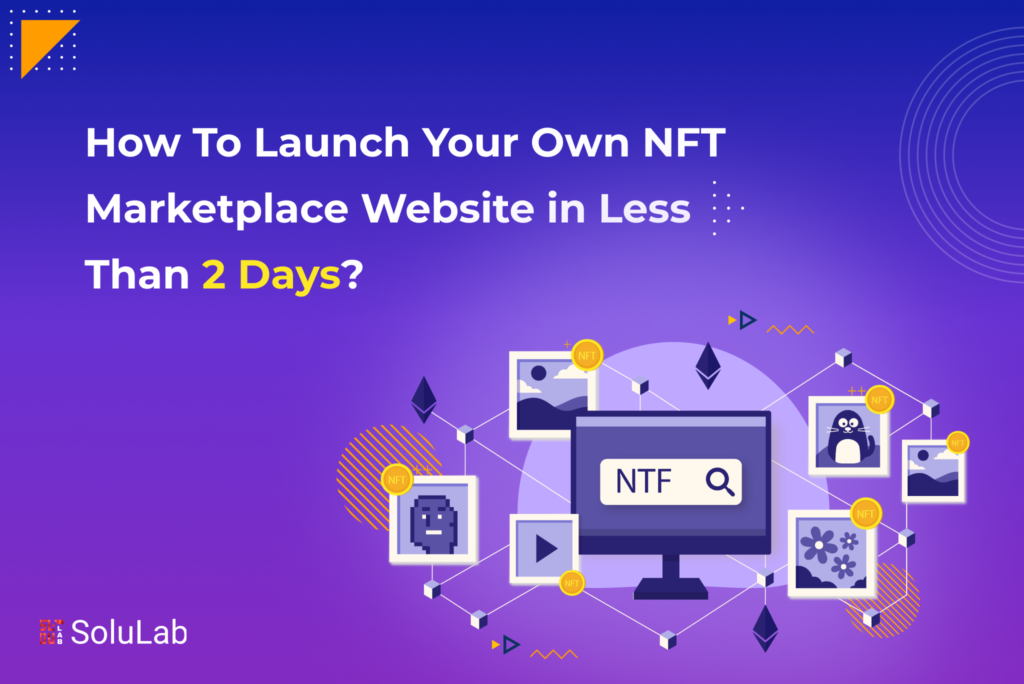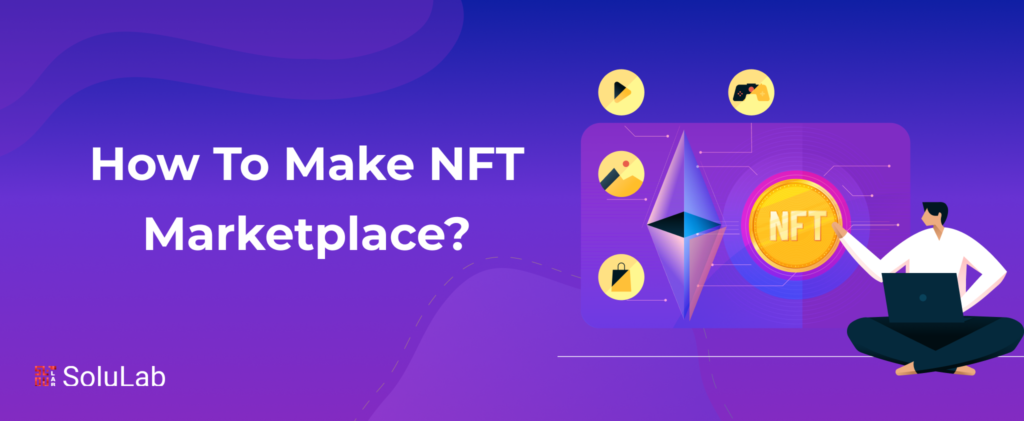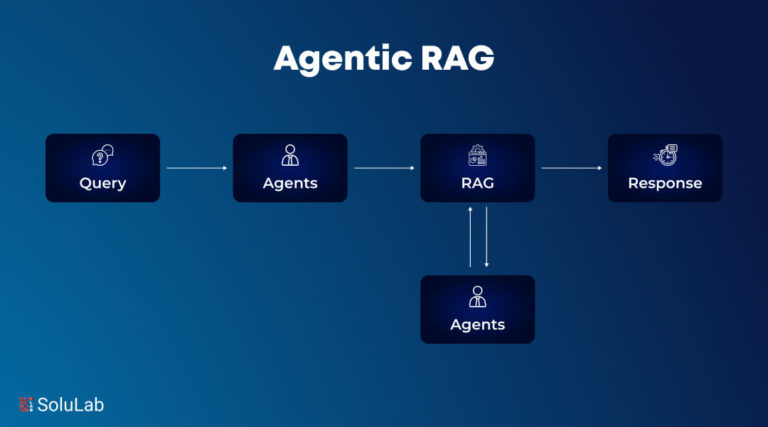
The number of online marketplaces for digital collectibles is growing every day. If you want to join the market, you’ll need to build your own marketplace. Many people use different marketplaces to buy or sell products, and we already know about Blockchain technology and various cryptocurrencies.
NFT (non-fungible token) is a marketplace that runs on a public Blockchain platform. While this platform is still developing, it’s becoming more and more popular, which is why developers and entrepreneurs are creating similar marketplaces nowadays.
If you’re curious about how to make an NFT marketplace in less than 2 days check out this blog. We’ve covered everything you need to know when creating a marketplace.
What is an NFT Marketplace?
An NFT or Non-Fungible Token marketplace, is a platform where users can buy, sell, and trade unique digital assets known as NFTs. NFTs are cryptographic tokens that represent ownership or proof of authenticity of a specific digital item or piece of content, such as artwork, music, videos, collectibles, virtual real estate, and more.
Unlike cryptocurrencies like Bitcoin or Ethereum, which are fungible and can be exchanged on a one-to-one basis, NFTs are indivisible and have unique properties that make them distinct from one another.
In an NFT marketplace, creators or artists can mint and list their digital assets as NFTs for sale. Buyers can browse through the marketplace to discover and purchase these one-of-a-kind digital items using cryptocurrency. The marketplace acts as a platform for creators to monetize their digital creations and for collectors to acquire and own digital assets that have value and scarcity.
NFT marketplaces provide a decentralized and transparent environment for conducting transactions. The use of blockchain technology ensures the immutability and provenance of NFTs, providing a verifiable record of ownership and enabling secure and trustless transactions.
The rise of NFT marketplaces has revolutionized the digital art and collectibles industry, opening up new possibilities for creators and collectors alike. It has created a digital economy where unique digital assets can be bought, sold, and traded, unlocking value and ownership in the virtual realm.
How To Make NFT Marketplace?

We have merely scratched the surface of this captivating NFT revolution, which is both intriguing and rewarding for those with an entrepreneurial spirit. Individuals interested in launching their own NFT marketplace will discover it to be a profitable business opportunity. If that’s the case, please refer to the section on “How to construct an NFT marketplace?” for further details.
1. Identify Your Target Audience
Choosing a specific target demographic and area of expertise can aid in kickstarting your NFT marketplace development endeavor successfully. If you have a general concept, discuss it with developers to establish a strategy to launch your own NFT marketplace website in less than 2 days. Experts suggest concentrating on a specialized market rather than a broad one.
2. Creating User Interface Design
Developing the UI design is the most crucial step in creating any web product. When users first visit your platform, the UI design is the initial element they encounter. Therefore, the focus should be on crafting an exceptional user interface design that allows your users to easily navigate. After analyzing all aspects and objectives of NFT marketplace app development, experts create an optimal user interface to attract users.
3. Selecting the Architecture of the NFT Marketplace
NFT markets based on microservice architecture, ensure the best user experience and enable seamless platform operation. The microservice design permits individual components of the application to be updated or fixed without redeploying the entire program.
The microservice architecture consists of multiple independent components that are loosely connected to form an application. If one microservice experiences an issue, it won’t impact the rest of the services in a large application.
We can scale the necessary services at any time because they are separate. With smaller codebases, these services can be deployed more rapidly. Microservices make managing large-scale solutions more feasible while providing flexibility, productivity, and scalability. Major companies like Netflix, Uber, Amazon, and others also utilize microservice architecture.
4. Incorporating NFT Tokens
Once the blockchain network is chosen, the NFT requirements are established with the customer in mind. The token is developed to interact with the primary functions of the software. The NFT token is created to meet high standards and involves several steps, including constructing the domain name, minting the token, ensuring security, and setting up the token address.
5. Creating NFT-Based Smart Contracts
The NFT marketplace relies on various smart contracts that are built to perform different functions. From listing to trading NFTs, all the processes within the marketplace rely on smart contracts. For a decentralized NFT marketplace, smart contracts are designed to ensure smooth auctions, verification, and other purposes.
After examining the key characteristics and functionalities of the marketplace, experts create smart contracts. These self-executing programs carry out specified tasks and record all metadata associated with each generated NFT.
Check Out Our Article: SoluLab Recognized by GoodFirms as the Best Company to Work With
6. Including NFT Minting Attributes
The process of NFT minting can be classified into two types.
- Single-mode NFT Minting: This involves the smart contract code for ERC721 (Non-Fungible Tokens) that are unique and cannot be duplicated or altered.
- Multi-mode NFT Minting: This pertains to ERC1155 (Semi-Fungible Tokens) that can be replicated, allowing for the production of smart contract code.
Based on the client’s business requirements, smart contract codes for both single-mode and multi-mode NFT minting can now be developed and integrated into the platform’s backend.
7. Configuration of Database and IPFS NFT Storage
Database storage and IPFS are necessary for business and research purposes. The database ensures consistent data storage, efficient query execution, and high-performance usage. IPFS is a widely used file storage system that automatically backs up and versions files.
A well-designed database ensures quick access and retrieval of information. It is known for secure file sharing, fast streaming speed, and encrypted messaging.
8. Testing the Project Using Test Cases
The testing phase is crucial in ensuring the quality of the NFT marketplace apps or other products. It begins after the development and integration of the basic functionalities into the platform’s backend. The entire product undergoes a series of tests to identify defects, malfunctions, and address underlying concerns.
This phase employs various testing methodologies to ensure the smooth functioning of the platform. It can be categorized into two significant stages: verification and validation, which enhance the platform’s quality and foster client satisfaction.
9. Testnet Release or Final Deployment
Once the entire product has undergone testing to evaluate real-time activities, such as platform speed and module functionality flow, as well as gather client feedback, the NFT marketplace will be transitioned to testing networks. This step confirms the platform’s real-time operations.
This is a crucial stage that should never be overlooked, as it ensures the product is ready for use. Upon completion of the preceding processes, the fully tested, bug-free, resilient, and fully functional NFT marketplace is deployed on the client’s production server and made available to the public.
Undoubtedly, the concept of the NFT business is still in its early stages. There are a few established and well-known NFT markets that have exemplified how to develop a flawless NFT marketplace by adopting the best features while addressing any shortcomings.
Functions of the NFT Marketplace
The marketplace platform should be filled with features that facilitate easy actions for both artists and customers.
1. Interface of the store
The interface of the marketplace is the first thing that captures the attention of the customer. The user interface should be user-friendly and present a captivating preview of the artwork. Additionally, it should consider the amount of information displayed on the screen for items available for sale.
2. Search and Filtering Options
Customers should be able to easily discover and filter the items they want to purchase amidst the listings. Filtering can be done based on the artist, the focal point of art, or the type of production using keywords or tags.
Other filtering options include sorting by date, distinguishing between auctions and direct purchases, and arranging prices in ascending or descending order. It’s important to note that the easier it is for customers to find what they want, the more successful the platform will be.
3. Listings by the Creators
Users should have a seamless experience with the user interface, while artists should find it effortless to create their listings. They should be able to upload their artwork, generate a token for it, provide a name, set a price, and choose whether to auction it or offer it for direct purchase. Although this step may seem simple, it requires thorough research for artists to decide on the appropriate pricing and listing type for their creations.
4. NFT Purchases
Both creators and customers should encounter no difficulties when purchasing an NFT. Customers should be able to make swift payments using the marketplace’s cryptocurrency wallet. After deducting the platform’s commission for facilitating the transaction, the creator should be able to quickly benefit from the sale.
5. Cryptocurrency Wallet
As you may already know, the crypto wallet plays a crucial role in the NFT marketplace ecosystem. The wallet should be highly secure and support multiple cryptocurrencies.
It’s important to note that, like a cryptocurrency exchange, the NFT marketplace has a certain level of centralization, which inevitably entails a decrease in security. Therefore, simple yet effective measures such as two-factor authentication and multi-signature login should be implemented to safeguard the crypto wallet.
6. Evaluations and Rankings
Evaluations and ratings are vital in motivating creators and guiding customers to the right artists. Creators should be rated based on the type of art they produce, the level of complexity, the conceptual strength behind their work, and the value they offer. Likewise, creators should be able to provide ratings for customers based on their interactions and transactions.
Strategies to Launch and Promote Your Marketplace Website

Outlined below are some promotional tactics to focus on during your pre-launch marketing campaign and promotional events. A marketing campaign is crucial before your product is unveiled. You should not hesitate to employ techniques that best align with your needs and objectives. The goal is to gain maximum traction and generate buzz around your platform.
Read Also: How to Create your own NFT Marketplace: Step-by-Step Guide
1. Craft a Sign-Up Message for Launching Your Marketplace Website
To generate pre-launch interest among your audience and garner initial sales figures, consider creating a sign-up message and sending it to your contacts. This message should pique their curiosity about your product’s pre-launch. Utilize a landing page as the foundation for your sign-up campaign. Begin gathering user sign-ups a few months before your actual release to have an established audience at launch.
2. Engage Online Marketplace Communities
Utilize social media platforms like Facebook, Twitter, LinkedIn, and Instagram to reach a broader audience. If your target customers are active in Facebook groups, join those groups and start participating in discussions, sharing your marketplace ideas and benefits, and inviting feedback.
If you manage to generate interest, direct people to your landing page to sign up for emails. Create captivating visuals, short videos, and compelling posts revolving around your marketplace to capture people’s attention. You can also enhance the reach of your content through paid advertisements.
3. Harness the Power of Media
Thoroughly understand your audience, particularly the channels they follow for the latest news. Media can be a powerful tool to create a buzz around the launch of your online marketplace business. Media coverage can also attract investors. Ensure that you select the news channels followed by your target audience.
4. Highlight the Key Advantages of Your Product
You have recognized the need for a dynamic online platform and put in the effort to create one. Ensure that you understand all the obstacles your platform overcomes and the solutions it provides. Now, you need to communicate these benefits to your audience.
Examples of potential value propositions include reduced fees, user-friendly navigation, impressive user experience, a wide variety of brands, or a secure payment platform. Whichever promotional channel you choose, make sure to incorporate your value proposition.
5. Surprise Your Audience
Everyone loves surprises, and you can be creative in your approach to promoting your marketplace. Giveaways can leave a lasting impression on people, ensuring that they remember you and your cause. Consider offering personalized postcards or sending gifts to your subscribers’ doorsteps. Such surprises will capture attention and spark excitement around your marketplace launch among the recipients. The public will likely appreciate your creativity and enthusiasm for introducing your marketplace in a personalized manner.
6. Utilize Email Marketing
If you have accumulated a substantial number of contacts over time, leverage them to remind your contacts about your business goals. When you are nearing the launch of your online marketplace, send direct emails to inform your contacts about the upcoming launch. Establish communication through an initial email and provide updates. Later, include a link for them to register on your marketplace.
7. Start Blogging
Create a blog and publish relevant articles related to eCommerce, online business, and the benefits of engaging with your marketplace. Write compelling content on topics associated with your marketplace to drive more traffic. Include a call-to-action with a sign-up link at the end of each post to generate leads and build an email list of individuals interested in your marketplace.
8. Engage Influencers
Collaborate with influencers who have a strong online presence to generate positive exposure for your marketplace pre-launch and enhance its credibility. Reach out to bloggers, social media marketers, and other industry figures.
To get people talking about and promoting your marketplace, you might offer them free trials, early access to the website or app, or other incentives.
Cost of Creating an NFT Marketplace
Creating a venue where individuals may buy, sell, and exchange non-fungible tokens (NFTs) is the goal of developing such a marketplace. The cost of creating an NFT marketplace will vary from case to case.
One of the most important factors that might affect how much it costs to create an NFT marketplace is the technological stack that is used. The total cost of the platform’s creation will change depending on the specific languages, frameworks, and databases that are used in its creation.
Read Our Blog: Everything You Need to Know About Metaverse NFT Marketplace Development
1. Designing for the Front End
Designing the website’s interface and any client-side NFT marketplace script required to enable user interaction is what’s known as “front-end programming.”
Front-end development may cost anything from $5,000 to $20,000 (or more, depending on the hourly rate of the NFT marketplace developer) based on the intricacy of the design and the number of pages or screens needed. Front-end developers’ starting hourly pay is about $30/hr, however, this might go up as their expertise and experience grow.
2. Creation of the Backend
Creating the database architecture and server-side code for handling transactions, NFT management, and user authentication is part of this process. Back-end development might cost anywhere from $10,000 to $50,000, depending on the complexity of the project and the requirement for scalability.
3. Adopting Blockchain Technology
Integrating a blockchain network (like Ethereum or Binance Smart Chain) into an NFT exchange is a crucial aspect of the process. Depending on the scope of the integration and the blockchain platform used, the price tag for incorporating a blockchain might range from $10,000 to $50,000.
4. Verification and Quality Control
Finding and fixing software flaws is a major part of testing and quality assurance. Depending on the degree of complexity of the application and the number of tests needed, the cost of testing and quality assurance might be anywhere from $5,000 to $15,000.
Depending on the scope of the project, the overall cost of creating an NFT marketplace might vary from $35,000 to $150,000. Please keep in mind that these are only ballpark values, and the actual cost will likely vary considerably dependent on the exact features and functions required.
5. Privacy
SSL certificates, encryption, and two-factor authentication are all part of the security infrastructure that must be set up. Security costs may run as high as $15,000, depending on how intricate your needs are.
Advantages of Your Own NFT Marketplace Website
NFTs employ blockchain technology, similar to cryptocurrencies, which also applies to non-fungible token marketplaces. Consequently, your digital platform for NFT sales reaps all the benefits associated with blockchain. Let’s explore the key advantages of NFT marketplaces.
1. Decentralization
A decentralized NFT marketplace involves creating a platform where users can freely trade assets without relying on traditional financial institutions or regulators. This decentralization is made possible through the utilization of blockchain technology.
2. High Level of Security
Blockchain technology empowers NFT marketplaces to benefit from robust security features. These features include cryptography and consensus algorithms, ensuring top-notch security measures are in place.
3. Indivisible Nature of NFTs
Every NFT possesses a unique digital identifier and distinct characteristics. Users can instantly access exclusive assets available through your marketplace. The distinctiveness of indivisible tokens makes them highly desirable.
4. Complete Transparency
Blockchain technology ensures that all NFT transactions are transparent and visible within a distributed database. Imagine it as a ledger of transactions that showcases real-time activity on your marketplace.
5. Liquidity
The demand for cryptocurrencies and NFTs continues to rise. Individuals value decentralization and the absence of standardized regulation, leading them to actively invest in digital assets. Consequently, the NFT sector experiences increased liquidity.
6. Authenticity and Unique Ownership
Building an NFT marketplace presents an opportunity to earn the loyalty and trust of users. A non-fungible token serves as a publicly accessible record of ownership, which can be verified if needed. As a result, forging an NFT becomes impossible.
Conclusion
Launching your own NFT marketplace website in less than two days requires careful planning, leveraging existing solutions, utilizing user-friendly website builders, focusing on key development elements, and implementing effective marketing strategies. With the right approach and dedication, you can turn your vision into a reality and join the exciting world of NFTs in no time.
When it comes to NFT marketplace development, SoluLab emerges as the perfect choice. With its extensive expertise in blockchain technology and a proven track record of delivering successful projects, SoluLab offers unparalleled benefits and services. From end-to-end NFT marketplace solutions to the seamless integration of smart contracts and secure transactions, SoluLab ensures a reliable and innovative platform for individuals and businesses venturing into the world of non-fungible tokens. Trust SoluLab to bring your NFT marketplace vision to life with efficiency and excellence.
FAQs
1. How can I make an NFT marketplace in less than 2 days?
To create an NFT marketplace quickly, you need to identify your target audience, design the user interface, choose the right architecture, incorporate NFT tokens and smart contracts, configure database and IPFS storage, conduct thorough testing, and deploy the finalized marketplace.
2. What are the functions of an NFT marketplace?
An NFT marketplace should have a user-friendly store interface, search and filtering options for easy item discovery, listings by creators, smooth NFT purchases with cryptocurrency wallets, evaluations, and rankings for creators and customers, and secure transactions.
3. How can I promote my marketplace website?
To promote your marketplace website, you can craft a sign-up message, engage online marketplace communities, leverage media coverage, highlight key advantages, surprise your audience with giveaways, utilize email marketing, start blogging, and collaborate with influencers.
4. What is the cost of creating an NFT marketplace?
The cost of creating an NFT marketplace depends on factors such as front-end and back-end development, adopting blockchain technology, and verification and quality control. The overall cost can range from $35,000 to $150,000, depending on the complexity of the project.






